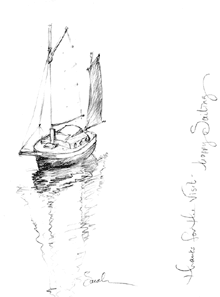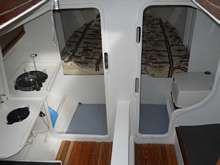A few years before retirement, I decided to build a sailboat to explore the beautiful Pacific Northwest coast. I chose the centerboard Penguin cabin cruiser by John Welsford because it had a particularly spacious cabin.
 |
The Ann Martin on her trailer. |
It's a big boat. With a 21' length and 8' beam, it's at the practical limit of being easily trailered. Nevertheless, the build is within the reach of a modestly skilled woodworker with the available space. My only experience was having built a Banks dory. When I got the plans for the Penguin, I was discouraged at first, but I broke it down in steps and went ahead.
The build space was our double garage, which has a workshop extension for a total length of 30 feet. It took about 1000 hours over four years to launch the boat for a float test. Knowing that the hardest obstacle with any long term endeavor is keeping up interest, I tried to accomplish something to advance the project every day I was home, even if it was just putting in a screw. It's important to perceive progress, no matter how small.
Technically, the curved cabin was the most difficult step, and at least one Penguin builder squared it off. Appearance wise, the boat has an Old World look and would never be called modern. I've only heard favorable comments about its appearance, the most common being that it must be a renovated fishing boat. I've shown it twice at a wooden boat show, and both times an artist has chosen it as a subject for their art.
 |
Sketch by Sarah Gayle, 2014. |
I purchased materials that in my opinion were suitable and durable, but reasonably priced. For example, I used marine grade plywood, but the least expensive I could find locally. The paint is quality house paint. The mast was a Douglas Fir tree from the backyard that I debarked and dried vertically for a year outside. Boom, gaff and mizzen mast are from dimensional lumber. The epoxy was Duckworks' 2:1 economy epoxy. I made my own cleats. The tabernacle is white oak instead of welded stainless steel. I sowed the mizzen sail from a Sailrite kit, which I found easy to do with a regular sewing machine, and my sister's directions. Shrouds and forestay are made of Dyneema, which I recommend for an amateur build, laced to the chainplates. The chainplates are 1/4" brass bars from Duckworks backed inside with hardware steel plates, which saved a few hundred dollars over 14" commercial stainless steel chainplates. I estimated that strength is similar because the brass bar is a lot thicker, and that furthermore the short gaff mast exerts less force, plus brass does not microfissure and is easily handled.
Various cost savings allowed me to build a relatively large boat at a reasonable price. I wanted to have resources left to go cruising. I've not had any problems with the materials so far. The most expensive items in decreasing order of cost were trailer, ballast, outboard engine, sails and epoxy. I used two 9 foot steel bars for ballast (approximately 450 pounds each) rather than lead; this choice had to do with availability of lead and cost of smelting. If I had to redo, I would cast rebars in concrete within a ballast box of the appropriate size, which would be a significant saving.
The plans offered a number of sail configurations, but the gaff yawl is the most practical for a trailer boat because its spars are short. An added benefit is that yawls look good. The main boom and mizzen mast with spars fit inside the cabin, which is desirable for trailering. I can lash the sails to the spars with shock cords, shove them in the boat and not worry about damage. The main mast is about the length of the boat and its 40 pound weight makes it easy to lift by myself. The mizzen sail is larger than called for and works hard. I've not had any issue with weather helm.
Here are a few more comments. I first used a 2HP outboard, which was good enough, but it had no reverse and soon developed reliability issues. I moved up to a 6HP, and now carry a sculling oar. The outboard is sheltered in the cockpit, which is already smallish and starts to feel crowded with more than two occupants. The cabin's aft wall blocks the forward view and one needs to stand or sit on the side deck to see forward. The cabin is ample for a 20 foot boat and my 5'4" wife can standup under the sliding hatch.
The V-berth is double bed size in width and has sitting room. I circumvented the placement of the mast compression beam in the middle of the berth, required for the yawl, by placing the mast on top of a compression box that wraps around the berth and transfers compression to the keelson but keeps support out of the sleeping area. That attempt at engineering has worked out well and there has been no detectable movement. The cabin can sit up to four, and there are two long quarter berths, usable for storage. There is a semi-private head, an adequate galley, and a lot of room for storage of clothing, food and cooler. Staying aboard for a week is not a hardship. In the cabin, I opened up both sides of the berth. The original design called for a single starboard entrance, but that configuration was too awkward for us. Whoever slept portside would have had to crawl over the other person to get out.
 |
A view of the cabin from the main hatch. |
My wife and I have sailed the 'Ann Martin' overnight a number of times, notably on a six day long Columbia 150 expedition in 2013. Tom Luque (of MastGate) has posted a short clip of our boat sailing on the first day of the cruise. The Youtube clip by Tom Luque:
In the coming years, we plan to explore the San Juan Islands and the Salish Sea, maybe even try to reach Alaska sailing the Inside Passage.
 |
On the Yaquina River, OR (photo by John Kohnen 2013). |
 |
High and dry |
It's not a hard boat to sail overall although it took us some time to learn how to handle the novelty of a mizzen sail. The spanker is actually quite powerful and the bumpkin broke the first time out. I also designed and ordered a topsail, and look forward to trying it out. Overall, it's a big stable boat and it conveys confidence and security. The centerboard is useful in the shallows and the flat bottom makes beaching or being stranded on tidal flats uneventful. It tacks easily, points reasonably well for a gaffer, and is fast enough for cruising. The main drawback is set up time from trailer to water, which can be over two hours and makes it a poor choice for day sailing. It's a two person coastal cruiser, and in that role it does very well.
 |
Waiting for high tide. |
|












